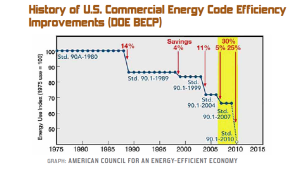Retrofitting and renovating existing buildings may be a costly endeavor, but these investments can deliver owners thousands in savings. How? By updating buildings to meet the most recent energy codes. Although it may be easy to see how the energy code influences updating or replacing building systems, the relevance of the energy code to renovations is less transparent.
Building owners may renovate for numerous reasons unrelated to energy use but can still increase their energy efficiency because of new code requirements and opportunities to incorporate some energy-conservation measures directly into the renovation.
Energy-code Basics
Energy codes are essentially a part of our building codes, which govern the design and construction of residential and commercial structures. Builders must comply with energy codes in the same way they comply with life, health and safety codes to ensure minimum standards of safety and quality. Buildings constructed to meet the most current model energy codes use less energy, keeping more dollars in the pockets of owners and their tenants.
Major renovations of commercial buildings are likely to trigger mandatory energy-efficiency measures under the International Energy Conservation Code (IECC) or ASHRAE Standard 90.1, the two primary building energy codes for commercial buildings. The current national model codes are the 2012 IECC and ASHRAE Standard 90.1-2010.
While communities often adopt the two codes together, they are not identical. IECC covers residential and commercial buildings; Standard 90.1 covers only commercial. However, IECC accepts demonstrating compliance with Standard 90.1 to comply with IECC commercial requirements.
Most states have the power to adopt these codes, though many also delegate that authority to local jurisdictions. Additionally, many communities adopt codes above the standards set by their state. Before starting any new project, it is important to know what code is required by the community.
The process differs from jurisdiction to jurisdiction, but in most cases codes are adopted through a legislative process, a regulatory process or some combination of both. Every state is unique in how it conducts business and creates policy, and each state requires its own particular strategy for achieving the best possible code for its local governments, citizens and businesses.


